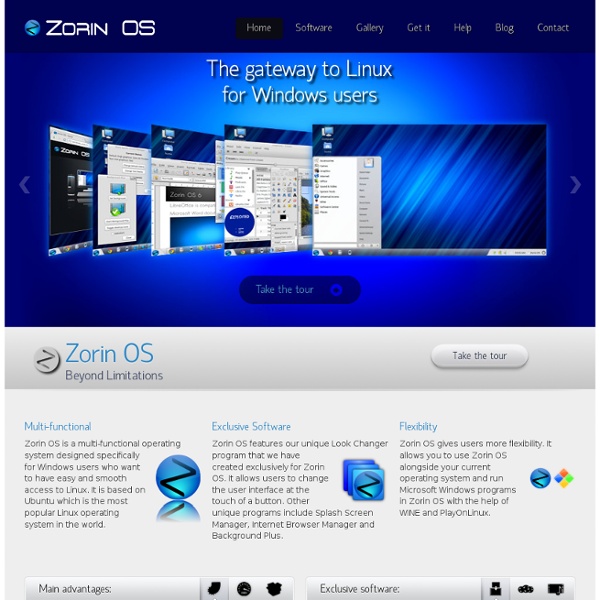



Slackware Puppy Linux Fuduntu • Home KDE KNOPPIX -=> KNOPPER.NET News <=- KNOPPIX 4.0.1 Released Starting from version 4.0, the KNOPPIX-project has been split into a DVD "maxi" edition, and a "KNOPPIX light" on CD, both developed in parallel. The limited, printed first edtion of the KNOPPIX 4.0 DVD (booting in german by default) has been available at LinuxTag 2005 at different booths, and is now available for download as updated 4.0.1 release on most KNOPPIX Mirrors. Because of many updates and technical improvements in the meantime since the 4.0 DVD, work on the Knoppix "light" CD release has been delayed somewhat. Main features of the Knoppix 4.0.1 DVD [original german press note]: Knopper.Net is not responsible for the content of external web pages
Pear Linux » Great new feature Pear Linux 6 is a fast, stable, and powerful operating system for everyday use. It’s completely free to use, study, and share. Pear Linux 6 is easy to use And it comes with thousands of free applications. Pear Linux 6 does everything you need it to. Pear Appstore gives you a handy way to choose and install desired applications by one click. Click on “Pear Linux 6″ (Top left of the screen) and the Launchpad open to show you your installed software : Each app is represented by an icon, and Launchpad creates as many pages of app icons as you need. Screen Shots Recommended Requirements Minimum System Requirements Personal computer with an Intel Pentium III 500 MHz or higher processor 512 MB physical RAM 8 GB available disk space 800×600 display resolution SliTaz SliTaz GNU/Linux is a light-weight, community-based Linux distribution suitable for use on older hardware or as a Live CD or Live USB.[3][4][5][6] System requirements[edit] SliTaz GNU/Linux is supported on all machines based on the i486 or x86 Intel compatible processors.[2] The Live CD has four variants of SliTaz, requiring from 192 MB of RAM for the Core system to 48 MB for a text mode and X Window System.[2] Slitaz can even run in 16 megabytes of RAM and a little swap memory. [7] SliTaz can be booted from a Live CD, Live USB, floppy disk, or a local area network,[8] or can be installed, requiring approximately 100 MB of hard disk space.[9] Release history[edit] Gallery[edit] See also[edit] References[edit] External links[edit]
Debian Oneiric - From Also see info about the most recent LTS version, Precise Pangolin (12.04 LTS). Introduction On October 14, 2011, Ubuntu 11.10 was released. It is codenamed Oneiric Ocelot and is the successor to Natty Narwhal 11.04 (Natty+1). General Notes General Notes This is the original Ubuntuguide. Menu -> File -> Open Terminal Text inside the grey dotted box like this should be put into the command-line Terminal. Many changes to the operating system can only be done by a User with Administrative privileges. sudo bash 'gksudo' can be used instead of 'sudo' when opening a Graphical Application through the "Run Command" dialog box or as a menu item. gksudo gedit /etc/apt/sources.list Many file management tasks can be accomplished with root Administrative privileges by starting the Nautilus file manager in a similar fashion. gksudo nautilus or sudo nautilus "man" command can be used to find help manual for a command. man sudo sudo apt-get install package Other versions Open the command terminal and type: Run:
SliTaz GNU/Linux LinuxMint Debian Important links LMDE in brief Linux Mint Debian Edition (LMDE) is a semi-rolling distribution based on Debian Testing. 1. No, it is not. 2. Yes, 100%. 3. Updates are constantly fed to Debian Testing, where users experience frequent regressions but also frequent bug fixes and improvements. 4. Pros: You don’t need to ever re-install the system. Cons: LMDE requires a deeper knowledge and experience with Linux, dpkg and APT. Internet U.S. Army soldiers "surfing the Internet" at Forward Operating Base Yusifiyah, Iraq The Internet is a global system of interconnected computer networks that use the standard Internet protocol suite (TCP/IP) to link several billion devices worldwide. It is a network of networks[1] that consists of millions of private, public, academic, business, and government networks of local to global scope, linked by a broad array of electronic, wireless, and optical networking technologies. The origins of the Internet date back to research commissioned by the United States government in the 1960s to build robust, fault-tolerant communication via computer networks.[2] This work, combined with efforts in the United Kingdom and France, led to the primary precursor network, the ARPANET, in the United States. Terminology The Internet, referring to the specific global system of interconnected IP networks, is a proper noun and written with an initial capital letter. History T3 NSFNET Backbone, c. 1992. Access
Yeah but if you were a complete noob to Linux and computers all together for that matter it would be a nice start by taranasus Jun 19